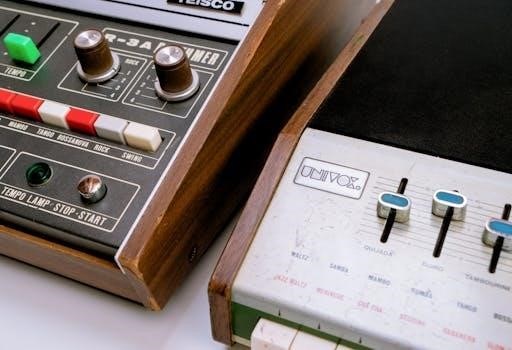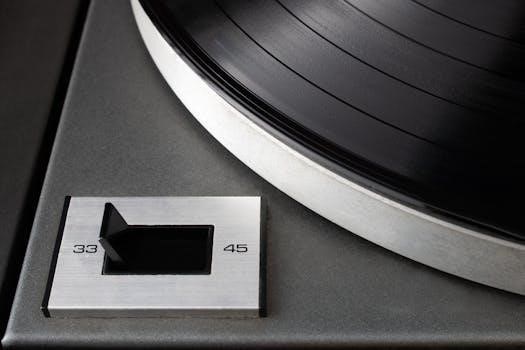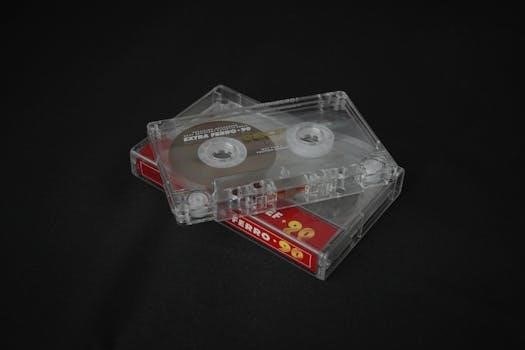Ishkur’s Guide to Electronic Music is a cult classic‚ initially a Flash-based interactive website. It served as a gateway for many into the world of electronic music. The guide categorizes and explores numerous genres and subgenres‚ offering a unique perspective.
Overview of the Guide’s Purpose and Impact
Ishkur’s Guide to Electronic Music‚ in its original form‚ aimed to provide a comprehensive and often satirical exploration of electronic music genres. The guide was intended to be an educational resource‚ mapping out the complex web of electronic music history‚ from its earliest forms to the diverse subgenres. It gained a significant following for its unique approach‚ utilizing an interactive interface and audio samples to illustrate the nuances of each style. This helped users discover music‚ artists and subgenres they may not have otherwise been exposed to‚ and for many‚ it was a pivotal first step into the electronic music scene. It became a valued and influential resource.

Key Features of the Original Ishkur’s Guide (v2.5)
The original Ishkur’s Guide (v2.5) featured an interactive Flash interface. It allowed users to explore electronic music genres and subgenres through a visual and auditory experience.
Interactive Flash Interface and Genre Exploration
The original Ishkur’s Guide to Electronic Music utilized a Flash-based interface‚ providing a visually engaging way to navigate the vast landscape of electronic music. This interactive design allowed users to click through a branching structure of genres and subgenres‚ discovering new sounds and artists. The interface was intuitive‚ enabling users to explore the relationships between different styles of music. Starting with parent genres like House‚ Techno‚ and Trance‚ the guide displayed how these styles branched out into numerous subgenres. This exploratory approach made the guide an engaging and educational tool for music enthusiasts.
Structure⁚ Parent Genres and Subgenres
Ishkur’s Guide to Electronic Music was meticulously structured‚ employing a hierarchical system of parent genres and subgenres. The guide started with broad categories such as House‚ Trance‚ Techno‚ Breakbeat‚ Jungle‚ Hardcore‚ and Downtempo. From these parent genres‚ the structure branched into numerous‚ more specific subgenres. This organization allowed users to understand the evolution and interconnections within electronic music. Each subgenre was positioned to show its origins‚ and its place within the larger electronic music family tree. This clear structure made it easy for users to explore and learn about the diverse world of electronic music.
Use of Audio Samples within the Guide
A key feature of Ishkur’s Guide was its incorporation of audio samples. Each subgenre was accompanied by a short audio clip‚ providing users with a direct auditory experience of that particular style of electronic music. These samples‚ totaling 818 across 153 subgenres‚ allowed users to quickly grasp the distinct sonic characteristics of each genre. The audio component was essential for making the guide interactive‚ and also educational‚ bringing the theoretical aspects of genre definitions to life. This combination of textual descriptions and audio samples helped make the guide a very effective and engaging tool.
The guide was ported from Flash to HTML5 to improve accessibility and usability. This transition allowed for mobile-friendly access and ensured the guide’s long-term preservation.
Reasons for Porting from Flash
Improvements in Usability and Mobile Friendliness

Content and Scope of Ishkur’s Guide
The guide features a vast collection of 153 subgenres and 818 audio samples. It presents a chronological journey through electronic music history‚ from its early roots to modern forms.
Number of Subgenres and Audio Files
The original Ishkur’s Guide to Electronic Music‚ version 2.5‚ is renowned for its comprehensive cataloging of electronic music. It boasts an impressive 153 distinct subgenres‚ covering a vast spectrum of sounds and styles. Each subgenre is accompanied by audio samples‚ totaling 818 files. These samples provide users with a tangible experience‚ allowing them to hear the nuances and differences between various electronic music forms. The guide’s extensive scope makes it a valuable resource for both novice listeners and seasoned enthusiasts seeking to expand their knowledge of the genre. The sheer volume of content demonstrates the depth and breadth of electronic music.
Chronological Depiction of Electronic Music History
Ishkur’s Guide to Electronic Music‚ in its original form‚ attempts to portray the evolution of electronic music chronologically. The guide maps the development of genres‚ showcasing how they branched into subgenres. It presents a visual and interactive timeline‚ moving from the foundational influences to the more contemporary forms of electronic music. While not a strict historical account‚ it provides a structured overview of the emergence and progression of various styles‚ from early innovations to more recent developments. This approach helps users understand the relationships between different genres and their historical context‚ giving a sense of how electronic music has evolved.

Ishkur’s Guide as a Gateway to Electronic Music
The guide served as a crucial entry point for many into electronic music. Its interactive nature made exploring genres accessible and engaging‚ fostering a deeper appreciation of the diverse styles within the scene.
Its Role as an Educational Resource
Ishkur’s Guide functioned as a unique educational resource‚ mapping the complex landscape of electronic music. It presented a chronological depiction‚ tracing the evolution of genres and subgenres. The guide offered more than just names; it provided audio samples‚ allowing users to hear the distinct characteristics of each style. This interactive approach made learning about electronic music engaging and accessible. It helped users understand the lineage and development of various electronic music forms‚ acting as a primer for newcomers and a valuable reference for enthusiasts. The guide’s impact extends to how individuals explore and appreciate the genre‚ facilitating a deeper understanding of its history and diversity.
The Guide’s Satirical and Humorous Tone
Ishkur’s Guide to Electronic Music is not just an educational tool; it’s also known for its satirical and humorous tone. The descriptions of genres and subgenres are often witty and opinionated‚ adding an entertaining layer to the learning experience. The guide doesn’t shy away from making bold and often humorous statements about the quality and characteristics of various styles. This injects a personality into the website‚ making it more engaging and memorable. The satirical commentary provides a unique perspective that sets it apart from dry‚ academic resources. It’s this blend of education and humor that has contributed to the guide’s cult following. The tone is part of the appeal.
Availability and Accessing the Guide Today
Methods for Accessing Archived Versions (v2.5)
Due to the original guide being a Flash-based application‚ accessing the v2.5 version today requires specific methods. Users can find archived versions of the guide on various websites and repositories dedicated to preserving older web content. These archives often contain the necessary files‚ including the music.swf file‚ which can be run using a Flash player emulator. Some online resources provide direct links to download the archived data. It is essential to use a secure and reputable source when downloading these files to avoid malware. Additionally‚ some users have created local copies which can be accessed.
Recognizing the limitations of Flash‚ several initiatives have emerged to port Ishkur’s Guide to HTML5. These versions offer improved accessibility and mobile compatibility. Repositories‚ like the one on GitHub‚ host the necessary code and data for the HTML5 versions. These repositories often include the original audio samples and genre classifications. Users can typically access these HTML5 versions directly through web browsers‚ eliminating the need for Flash emulation. Links to these repositories and online versions are often shared in forums and communities dedicated to electronic music. This modern approach ensures the guide’s continued availability.

Ishkur’s Guide v3.0 and Its Updates
Ishkur’s Guide received a significant update with v3.0‚ marking the first major revision in 18 years. This version features a redesigned structure‚ expanded descriptions‚ and many more examples.
Significant Changes and Additions
The release of Ishkur’s Guide v3.0 brought substantial changes compared to the original v2.5. The genre tree was completely overhauled‚ offering a more refined and updated categorization of electronic music. Descriptions were entirely rewritten and significantly expanded‚ providing richer context for each genre. Furthermore‚ the number of audio examples was substantially increased‚ allowing for a deeper exploration of each subgenre’s unique sound. The update aimed to provide a more comprehensive and detailed overview‚ reflecting the evolution of electronic music since the initial release of the guide. This version represents a major leap forward in terms of both content and presentation‚ adding a huge amount of detail.
Expanded Descriptions and Examples
A key enhancement in later versions of Ishkur’s Guide was the significant expansion of both genre descriptions and audio examples. The original guide‚ while comprehensive‚ had limited text and audio. The updated versions feature much more in-depth descriptions‚ providing a richer understanding of each genre’s origins‚ characteristics‚ and key artists. In addition to the expanded text‚ the number of audio samples was greatly increased‚ allowing users to explore a wider range of musical styles within each subgenre. This combination of detailed text and varied sound clips created a much more immersive and educational experience for the users of the guide‚ making it a better resource.
